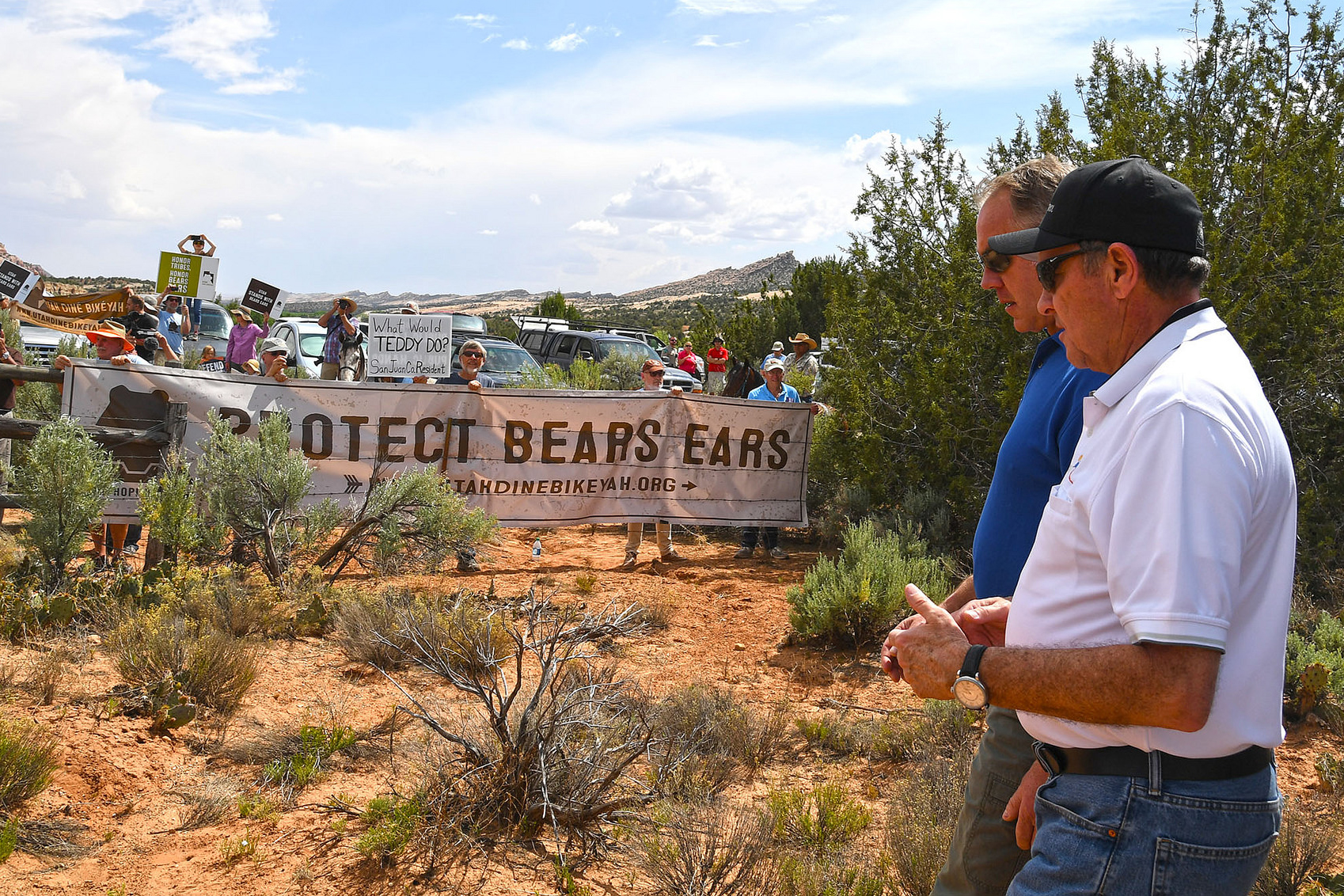What would actually happen if Trump rescinds a national monument?
When President Donald Trump ordered the review of some two dozen national monuments late last month, he declared that “tremendously positive things are going to happen on that land.”
Meanwhile, environmental and outdoor industry groups, among others, warned that the executive order was a move toward lifting protections on cherished landscapes and valuable ecosystems.
But would rescinding a national monument really unleash prosperity in rural communities or allow landscapes to be irreversibly degraded? Here’s a look at the potential environmental and economic consequences.
Have an opinion about the management of National Monuments? Click here to file an official comment with the Department of the Interior.
It Wouldn’t Necessarily Amount To Privatization
Under the Antiquities Act of 1906, the President can declare a national monument in order to protect “historic landmarks, historic and prehistoric structures, and other objects of historic or scientific interest.”
Though the act has long been used to preserve entire landscapes, some Westerners have pushed back against the federal government’s right to “lock up” vast swaths of land.
Echoing that rhetoric during his signing statement, Trump decried the “massive federal land grab” perpetrated by presidents past. He said he was “putting the states back in charge.”
In fact, a monument designation simply reclassifies land that the federal government already owns—and would continue to own in the event of a reversal.
“The lands would basically revert back to their prior status, under the managing agency,” Bob Keiter, a professor of law at the University of Utah, said.
Some state leaders note that federal designations usurp power from local interests, who may have differing opinions on the best ways to manage lands. As Utah Gov. Gary Herbert said of the Bears Ears designation:
“This decision ignores the will of the majority of Utahns. It disregards the desire of Native American groups who count these lands as their heritage to co-manage this culturally important area. It overlooks the unanimous opposition of Utah’s statewide elected officials and Utah’s entire congressional delegation. It runs roughshod over a resolution from Utah’s legislature opposing such action. Today’s designation demonstrates how overreach from the federal government often disregards the well-being and interests of rural Americans.”
Extraction Could Increase—In Theory
According to James Skillen, a professor of environmental studies at Calvin College and author of a book on the Bureau of Land Management, while the particulars of monument proclamations have differed, “the one common element is that presidents have withdrawn monument lands from new mineral entry.”

In other words, lifting a designation puts mining and oil-and-gas operations back on the table.
That could apply to multiple monuments under review. Grand Canyon-Parashant National Monument in Arizona, for example, has been mined for uranium in the past and could again, according to Roger Clark of the Grand Canyon Trust.
And it’s hardly a coincidence that Trump’s executive order extends back to 1996, the year President Bill Clinton created the controversial Grand Staircase-Escalante National Monument in southern Utah. Among other things, the 1.7-million-acre designation essentially put the kibosh on a proposed coal project in the now-protected Kaiparowits Plateau.
The return of such projects is not inevitable, though. It depends on the economic incentives and a company’s willingness to invest in land that might carry heightened legal and political uncertainty.
“It is possible that you’d see some attempts to mine those areas again with a change to the monument,” said Shawn Teigen, research director at the Utah Foundation and author of a recent report on the state’s coal industry. He was speaking of the Kaiparowits Plateau. “However, with an uncertainty around the area in terms of the future designations, environmental legal challenges, and demand, I would be a bit surprised.”
In Oregon, meanwhile, timber interests sued to block the Obama Administration’s January expansion of Cascade-Siskiyou National Monument, meant to protect biodiversity.
But not all the lands included in the expansion would open to timber anyway, said Michael Blumm, a law professor at Lewis & Clark.
“The people who are challenging the monument are hoping to see … a return to industrial logging,” he said. “Lifting the monument status itself wouldn’t guarantee that; BLM would have to go through its planning process.”
Grazing Wouldn’t Change Much
With a few exceptions, recent monument proclamations have allowed grazing to continue as before.

Monument status does add a layer of protection for the “objects” identified as significant. If grazing practices conflicted with that mission, they could be reevaluated.
But in general, unwinding monuments would probably have a negligible effect on grazing levels, if that.
“If it were only the Obama national monuments that were being reviewed, canceling would not have much impact on grazing,” said Thomas Power, an emeritus professor of economics at the University of Montana. “It takes decades for the national monuments to adjust grazing downward, if they do at all.”
Tourism Economies Could Be Disrupted
In 2015, Garfield County, Utah, announced a “state of emergency” due to declining school enrollment. The county commissioners blamed the adverse economic impacts of federal land-use restrictions. This includes Grand Staircase-Escalante National Monument, which occupies a chunk of the county.

While the struggles of places like Garfield are real, there is little evidence that federal land protections are to blame, said Chris Mehl, an economist at Headwaters Economics.
In fact, protected federal land can be a boon. “A monument can help diversify your economy,” Mehl said. Along with increased travel and tourism, he added, places with access to protected lands attract workers who prioritize quality-of-life factors and well-off early retirees.
Every county’s different of course, and hypotheticals are inherently fraught. But based on what we know from the research, it’s reasonable to expect that any given county will perform better economically over time with a national monument than without.
But even an unsuccessful attempt to roll back a monument designation could have unintended economic effects. That’s because a lengthy legal process would leave the land’s status in limbo.
Last year, the Obama Administration designated Katahdin Woods and Waters National Monument in Maine. At 87,000 acres, it’s the smallest preserve included in the current review.
Though initially controversial among Mainers, the monument has begun to win acceptance as the status quo, with local businesses recalibrating themselves around the new designation.
“There’s a lot of need for positive economic development,” said Mindy Crandall, a professor of forest management and economics at the University of Maine. “Increasing uncertainty really does not benefit anyone out there at this point in time.”
Probably A Losing Fight
There’s a very good chance this executive order is more bark than bite.
“There’s no provision for rescission of a monument in the Antiquities Act,” Keiter, the law professor, said. “It gives the President the authority to create monuments but not to revoke them.”
Congress does have that authority, but broad public support for monuments—even among Republican voters in the West—probably makes it a political nonstarter.
“I don’t think they have 218 [House] votes to undo monument designations,” said Athan Manuel, a lobbyist for the Sierra Club. “I think the White House completely underestimates how much support there is from Republicans for public lands.”
Then there are the various pro-conservation groups, from the Sierra Club to Patagonia, who said they will contest any monument reversals in court.
Not that Trump needs to rescind a monument to affect it. The administration could attempt to adjust borders, for which there is precedent. Or it could simply pursue policy goals administratively, sure to be easier (if less sexy) politically and legally.
“I suspect that Trump will discover this,” Skillen, the Calvin College professor, said, “and work through the planning process to shape management.”
Have an opinion about the management of National Monuments? Click here to file an official comment with the Department of the Interior.







